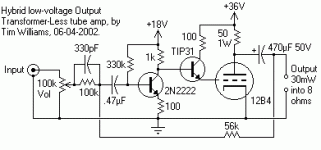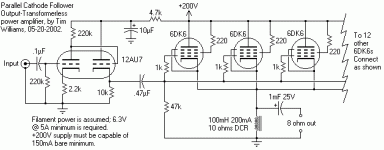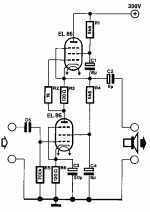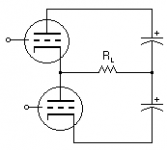For you OTL fans, here's one for you, all 1.5Watts.
(So Frank what do you think)
http://www.transcendentsound.com/single ended.htm
(So Frank what do you think)
http://www.transcendentsound.com/single ended.htm
6C19P, isn't that the mini-6C33C? Unless that's meant for 32 ohm speakers, they need a good four times more tubes... 
This reminds me. Wonder if I have the schematic...Ah!
 Was just screwin' around on the breadboard one day a long time ago, wondering how much I current I can get through the thing at low voltage without melting the grid.
Was just screwin' around on the breadboard one day a long time ago, wondering how much I current I can get through the thing at low voltage without melting the grid.
Tim
This reminds me. Wonder if I have the schematic...Ah!
 Was just screwin' around on the breadboard one day a long time ago, wondering how much I current I can get through the thing at low voltage without melting the grid.
Was just screwin' around on the breadboard one day a long time ago, wondering how much I current I can get through the thing at low voltage without melting the grid.Tim
Attachments
Hi,
SE OTL circuits can certainly sound great for a very limited number of applications as outlined in the link you posted.
One of the best known examples is the old Philips circuit of which I can say it amazed me tremendously as I tried it on 8 Ohm speakers where it was originally designed for 800 Ohm speakers.
You'll no doubt have noticed that the main design target was avoiding the OPT replacing it with a large value cap.
Everything else being taken proper care of the coupling cap will no doubt play a big role in the performance of the amp as will the PS.
Have you noticed the huge PS cap values and attention paid to the PS?
As with all SE amps the PS is in the signal path and will play a major role in achieving the best results from this topology.
Trying it out won't break the bank and the 6C19Pis are outstanding little valves....if you have the right speakers for it.
Cheers,
(So Frank what do you think)
SE OTL circuits can certainly sound great for a very limited number of applications as outlined in the link you posted.
One of the best known examples is the old Philips circuit of which I can say it amazed me tremendously as I tried it on 8 Ohm speakers where it was originally designed for 800 Ohm speakers.
You'll no doubt have noticed that the main design target was avoiding the OPT replacing it with a large value cap.
Everything else being taken proper care of the coupling cap will no doubt play a big role in the performance of the amp as will the PS.
Have you noticed the huge PS cap values and attention paid to the PS?
As with all SE amps the PS is in the signal path and will play a major role in achieving the best results from this topology.
Trying it out won't break the bank and the 6C19Pis are outstanding little valves....if you have the right speakers for it.
Cheers,
Hi,
Yup...it's closest parent being the TFK ED8000, a truly awesome noval triode and a longtime favourite of mine.
Cheers,
6S19P is pretty much 1/2 a 6AS7/6080
Yup...it's closest parent being the TFK ED8000, a truly awesome noval triode and a longtime favourite of mine.
Cheers,
(So Frank what do you think)
Yes, certainly a lot of attention has been paid to the P/S and I also noticed in this amp he uses a cap on the output.
I want to try an OTL but up to now have not.
Any schematics you can recommened ? Low power is fine, I have several horn speakers .
I have a copy of an old RCA using I think it was 12B4's as outputs. Are you familiar with it? Any Good?
I have been procrastinating over the Transcendent T-16 Stereo kit for almost a year. It reads well and and seems a bargin but I need the knowledge of others to guide me.
Thanks
Andrew
Yes, certainly a lot of attention has been paid to the P/S and I also noticed in this amp he uses a cap on the output.
I want to try an OTL but up to now have not.
Any schematics you can recommened ? Low power is fine, I have several horn speakers .
I have a copy of an old RCA using I think it was 12B4's as outputs. Are you familiar with it? Any Good?
I have been procrastinating over the Transcendent T-16 Stereo kit for almost a year. It reads well and and seems a bargin but I need the knowledge of others to guide me.
Thanks
Andrew
Hi,
Understandable...
These are not very common amps.
That's exactly where the dilemma is, it's nearly impossible to build
a low power OTL (especially considering high effiency horns) due to valves having high internal impedance ( several hundreds of Ohms at the least) compared to our average 8 Ohm speakers.
So inevitably you end up with much more power than you actually would need since, in order to lower the amps' Zo, you need to put a large number of output valves in // and apply a global NFB around the entire amp.
We also have to consider the fact that any residual noise in the amp is going to made audible on the horns...all in all a daunting task but not impossible.
Hmmm, I know of one OTL amp in the RCA manuals but that one uses the 6082 ( the aircraft version of the 6080 heated by a 26V supply).
There was also the Futterman OTL using the 12B4A.
My only familiarity with either one is from the electronics library I have.
Let's not forget either that these were designed for 16 Ohm speakers common at the time.
I won't stop you from trying it out but it won't surprise me if it would be a little too noisy with horn speakers.
You can count on me and no doubt other members here to help you out if needed.
A friend of mine once built the Taki OTL using Iwata horns and Onken loaded woofers.
I must say I didn't detect any audible noise on the tweeters bar a slight hissing on the tweeters when I stuck my ear into the horns' mouth.
He was not a beginner though, but it just proves it can be done.
This would have been audible with most any other amplifier anyway.
The outputcap can't be avoided with a SE OTL amp since its output stage is ran from a single positive B+ rail as opposed to the SEPP OTL which uses a bipolar supply which nulls to 0 VDC where the output signal is take to the speaker.
Hope I haven't scared you,
I want to try an OTL but up to now have not.
Understandable...
These are not very common amps.
Low power is fine, I have several horn speakers .
That's exactly where the dilemma is, it's nearly impossible to build
a low power OTL (especially considering high effiency horns) due to valves having high internal impedance ( several hundreds of Ohms at the least) compared to our average 8 Ohm speakers.
So inevitably you end up with much more power than you actually would need since, in order to lower the amps' Zo, you need to put a large number of output valves in // and apply a global NFB around the entire amp.
We also have to consider the fact that any residual noise in the amp is going to made audible on the horns...all in all a daunting task but not impossible.
I have a copy of an old RCA using I think it was 12B4's as outputs. Are you familiar with it? Any Good?
Hmmm, I know of one OTL amp in the RCA manuals but that one uses the 6082 ( the aircraft version of the 6080 heated by a 26V supply).
There was also the Futterman OTL using the 12B4A.
My only familiarity with either one is from the electronics library I have.
Let's not forget either that these were designed for 16 Ohm speakers common at the time.
I have been procrastinating over the Transcendent T-16 Stereo kit for almost a year. It reads well and and seems a bargin but I need the knowledge of others to guide me.
I won't stop you from trying it out but it won't surprise me if it would be a little too noisy with horn speakers.
You can count on me and no doubt other members here to help you out if needed.
A friend of mine once built the Taki OTL using Iwata horns and Onken loaded woofers.
I must say I didn't detect any audible noise on the tweeters bar a slight hissing on the tweeters when I stuck my ear into the horns' mouth.
He was not a beginner though, but it just proves it can be done.
This would have been audible with most any other amplifier anyway.
Yes, certainly a lot of attention has been paid to the P/S and I also noticed in this amp he uses a cap on the output.
The outputcap can't be avoided with a SE OTL amp since its output stage is ran from a single positive B+ rail as opposed to the SEPP OTL which uses a bipolar supply which nulls to 0 VDC where the output signal is take to the speaker.
Hope I haven't scared you,
fdegrove said:The outputcap can't be avoided with a SE OTL amp since its output stage is ran from a single positive B+ rail
Now now Frank, you can put this stage between rails just as well. Or likewise, connect a power supply in series with the speaker to null the voltage that way. Volts are volts...
Tim
Hi,
Sure that can be done but that's still going to require an outputcap to block DC isn't it?
I'm not sure I follow you on this one but I think I've seen this done by a Polish designer.
Can we be sure this arrangement is safe to use?
Any feedback is welcome, Tim.
Cheers,
Now now Frank, you can put this stage between rails just as well.
Sure that can be done but that's still going to require an outputcap to block DC isn't it?
Or likewise, connect a power supply in series with the speaker to null the voltage that way. Volts are volts...
I'm not sure I follow you on this one but I think I've seen this done by a Polish designer.
Can we be sure this arrangement is safe to use?
Any feedback is welcome, Tim.
Cheers,
Say we use a choke loaded CF output stage, couldn´t the choke be connected to a negative rail equal to the voltage drop across the choke?
I have some Philips 800 ohm fullrange speakers that would be nice to try out some time in an open baffle or something.
I guess they could be fed from a single EL86/6CW5 or something, or why not splitting one 6AS7 between both channels?
Could be a neat little project for a rainy day, and with the addition of a pair of mains toroids on the outputs it could drive regular 8 ohm speakers too.
Yeah, one 6AS7, one 6DJ8, two 10H/100mA chokes and a 200V power supply. That´s it.
I have some Philips 800 ohm fullrange speakers that would be nice to try out some time in an open baffle or something.
I guess they could be fed from a single EL86/6CW5 or something, or why not splitting one 6AS7 between both channels?
Could be a neat little project for a rainy day, and with the addition of a pair of mains toroids on the outputs it could drive regular 8 ohm speakers too.
Yeah, one 6AS7, one 6DJ8, two 10H/100mA chokes and a 200V power supply. That´s it.
Hi,
Yes, using either a cap or a OPT.
That's how the Philips EL86 based "OTL" amp was presented.
I wouldn't call it OTL but what the heck, it sounds great.
Note the resemblance to the totem pole, SRPP configuration; the driver was a 12AX7A, BTW.
Cheers,
I have some Philips 800 ohm fullrange speakers that would be nice to try out some time in an open baffle or something.
Yes, using either a cap or a OPT.
That's how the Philips EL86 based "OTL" amp was presented.
I wouldn't call it OTL but what the heck, it sounds great.
Note the resemblance to the totem pole, SRPP configuration; the driver was a 12AX7A, BTW.
Cheers,
Yes of course, but all you are doing is moving the coupling cap from the signal feed to the signal return line, even though you will re-designate it as a power supply cap.Fuling said:Say we use a choke loaded CF output stage, couldn´t the choke be connected to a negative rail equal to the voltage drop across the choke?
snip... That´s it.
Cheers,
Hi,
Very well, John...
Can anyone convince our Tim?
Shifting caps isn't going to cut it...
Which is why I'd stick to either the Futterman and its derivatives or empty all pockets and think circlotron.
Cheers,
Yes of course, but all you are doing is moving the coupling cap from the signal feed to the signal return line, even though you will re-designate it as a power supply cap.
Very well, John...
Can anyone convince our Tim?
Shifting caps isn't going to cut it...
Which is why I'd stick to either the Futterman and its derivatives or empty all pockets and think circlotron.
Cheers,
Hi,
Don't tell me I didn't tell you, Tim.
Shift them anyway you like...they're going to end up in the signal path one way or the other.
That's SE "OTL" for you...
Now analyse SEPP OTL just to do me a favour and tell me there's no cap in the signal path except the obvious coupling caps...
Cheers,
Well gee, if you want to get into semantics like that, then WTF are any of us doing with sheety AC power eh?
Don't tell me I didn't tell you, Tim.
Shift them anyway you like...they're going to end up in the signal path one way or the other.
That's SE "OTL" for you...
Now analyse SEPP OTL just to do me a favour and tell me there's no cap in the signal path except the obvious coupling caps...
Cheers,
Thanks frank for that and also the others for futher info.
The Phillips schematic looks simple and elegant, just what i need.
I just may give it a try.
Angela.com has el86 @$6.00 each but only four, 3 are "Admiral" and one Mullard, so no spares.
Quick question, is that 8uF cap on the output large enough to get bass from?
"One of the best known examples is the old Philips circuit of which I can say it amazed me tremendously as I tried it on 8 Ohm speakers where it was originally designed for 800 Ohm speakers."
I take it when you tried it with a 8R speaker you coupled thorough a transformer or no?
Any hints regarding construction on this amp?
Thanks
Andrew
The Phillips schematic looks simple and elegant, just what i need.
I just may give it a try.
Angela.com has el86 @$6.00 each but only four, 3 are "Admiral" and one Mullard, so no spares.
Quick question, is that 8uF cap on the output large enough to get bass from?
"One of the best known examples is the old Philips circuit of which I can say it amazed me tremendously as I tried it on 8 Ohm speakers where it was originally designed for 800 Ohm speakers."
I take it when you tried it with a 8R speaker you coupled thorough a transformer or no?
Any hints regarding construction on this amp?
Thanks
Andrew
fdegrove said:Now analyse SEPP OTL just to do me a favour and tell me there's no cap in the signal path except the obvious coupling caps...
Huh?
Shown are the PS caps, but if the top and bottom rails are supply voltage then they could be coupling caps. Same thing.
Tim
Attachments
- Status
- This old topic is closed. If you want to reopen this topic, contact a moderator using the "Report Post" button.
- Home
- Amplifiers
- Tubes / Valves
- class A S.E. OTL



